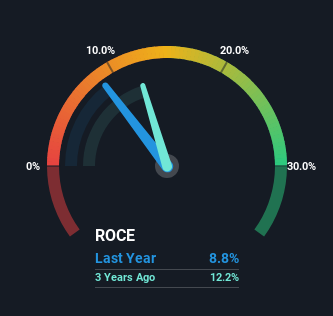Some Investors May Be Worried About Dollar Tree's (NASDAQ:DLTR) Returns On Capital
What trends should we look for it we want to identify stocks that can multiply in value over the long term? Typically, we'll want to notice a trend of growing return on capital employed (ROCE) and alongside that, an expanding base of capital employed. Basically this means that a company has profitable initiatives that it can continue to reinvest in, which is a trait of a compounding machine. Although, when we looked at Dollar Tree (NASDAQ:DLTR), it didn't seem to tick all of these boxes.
Return On Capital Employed (ROCE): What Is It?
If you haven't worked with ROCE before, it measures the 'return' (pre-tax profit) a company generates from capital employed in its business. Analysts use this formula to calculate it for Dollar Tree:
Return on Capital Employed = Earnings Before Interest and Tax (EBIT) ÷ (Total Assets - Current Liabilities)
0.088 = US$1.7b ÷ (US$24b - US$4.6b) (Based on the trailing twelve months to October 2023).
So, Dollar Tree has an ROCE of 8.8%. On its own that's a low return on capital but it's in line with the industry's average returns of 9.5%.
See our latest analysis for Dollar Tree
Above you can see how the current ROCE for Dollar Tree compares to its prior returns on capital, but there's only so much you can tell from the past. If you'd like, you can check out the forecasts from the analysts covering Dollar Tree here for free.
What Can We Tell From Dollar Tree's ROCE Trend?
When we looked at the ROCE trend at Dollar Tree, we didn't gain much confidence. Over the last five years, returns on capital have decreased to 8.8% from 14% five years ago. However it looks like Dollar Tree might be reinvesting for long term growth because while capital employed has increased, the company's sales haven't changed much in the last 12 months. It's worth keeping an eye on the company's earnings from here on to see if these investments do end up contributing to the bottom line.
What We Can Learn From Dollar Tree's ROCE
To conclude, we've found that Dollar Tree is reinvesting in the business, but returns have been falling. Since the stock has gained an impressive 43% over the last five years, investors must think there's better things to come. Ultimately, if the underlying trends persist, we wouldn't hold our breath on it being a multi-bagger going forward.
One more thing to note, we've identified 1 warning sign with Dollar Tree and understanding it should be part of your investment process.
While Dollar Tree isn't earning the highest return, check out this free list of companies that are earning high returns on equity with solid balance sheets.
Have feedback on this article? Concerned about the content? Get in touch with us directly. Alternatively, email editorial-team (at) simplywallst.com.
This article by Simply Wall St is general in nature. We provide commentary based on historical data and analyst forecasts only using an unbiased methodology and our articles are not intended to be financial advice. It does not constitute a recommendation to buy or sell any stock, and does not take account of your objectives, or your financial situation. We aim to bring you long-term focused analysis driven by fundamental data. Note that our analysis may not factor in the latest price-sensitive company announcements or qualitative material. Simply Wall St has no position in any stocks mentioned.

 Yahoo Finance
Yahoo Finance 
